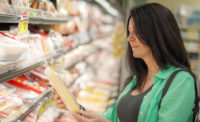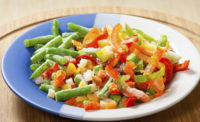Tyson Foods, Springdale, Ark., tapped its Tyson Trendtellers Council, made up of a dozen of the company’s top food thinkers and innovators, for their insights to create this year’s summer trends report.
Alternative protein has the heat
This summer, protein is the superhero, regardless of flavor, texture or variety.
And, the next generation of proteins are plant-based, in position to go mainstream, becoming a mainstay on menus, whether eating in or dining out.
The rise of the backyard grill master
This summer, the hottest trend is more people grilling like they’re professionals, complete with top-grade tools, tricks, techniques and more.
There are several reasons for this. First, backyard barbecuers are becoming more educated through the proliferation of how-to content on social media and video platforms. They are self-educating on tricks of the trade that were once only available to chefs in culinary school.
You are the Pro-Chef
Meat + Fire = Dinner.
Comfortable with that simple formula, consumers are starting to build their confidence, upping their level of skill and risk. Each cut is enhanced by layering flavors—sweet, salty, sour, bitter, umami— unlocking richer and deeper tastes. In addition to leveraging a variety of proteins and flavors, these backyard chefs are also bringing techniques like sous-vide, the reverse sear method and smoking to their summer barbecues.
The age of the machines
This is the next wave in grilling technology. From a technology perspective, the smart home is heading outdoors. This summer, consumers will be using a variety of grilling tech to perfect their craft. Want to add a smoky flavor to your meat? A dual-mode smoke controller enables consumers to produce a deep smoke flavor, and carefully monitor for consistent temperature. Some smartphones also double as a thermometer, using a wired probe to measure the temperature of the meat while cooking.
Frictionless food
Robots are starting to show up on college campuses and even at hotels, distributing snacks and room service to college students and summer travelers, respectively.
Robots are just one example of how the frictionless food economy continues to evolve. No longer are consumers willing to wait in long lines, or in some cases, even leave their home. The frictionless food economy is reducing the stress, time and tension encountered with some of the more traditional means of getting and making food.
As a result, more retailers are adding “click-and-collect” grocery pickup to their shopping options, along with direct-to-consumer delivery. Millennials and other more digitally minded cohorts are among the top consumers of these services and of the preponderance of meal kit options flooding the marketplace, all in the name of streamlining meal prep time.
Meet SIDE DISH 2.0
Food culture is on the rise and so too is the side dish. In fact, according to market research reports, side items are among the newest items added to menus in the casual and quick-service restaurant space. One difference is that consumers are seeking side dishes with a center-of-plate punch, regarding them less as meal complements and more as meal makers.
As barbecue goers decide what to bring to spice up the menu, they will be looking at interesting new flavor-packed ingredients, often adding proteins like chicken, beef or pork to increase the nutritional value and cut back on the carbs.
Kids’ summer eating list
Kids’ palates are slowly, but surely changing. They’re becoming mini-foodies, expanding their food preferences beyond the standard French fries and pizza.
Kids’ advanced palates are also leading them toward more nutritious foods. This summer, the power and potential of blended foods is coming to kids’ plates. Blended burgers and nuggets will be the new hot kids’ menu items, combining the flavors of traditional protein with the nutritional value of more plant-based ingredients.
Make way for snack time, anytime
Snacking used to be considered “The Fourth Meal,” a separate eating occasion that fell somewhere between the three squares. Over the past decade though, food processors have added 19 more between-meal occasions per capita. The reality is people are eating more fluidly throughout the day, which creates demand for flexible food that can be eaten anytime.
Snacks now come in anytime options.
Restaurants are also capturing the power of street food and small bites, with almost 14% of restaurant visits now being just for a snack or small plate, according to a report published by Technomic, Chicago. That means occasion-less dining in restaurants is on the rise. And, as restaurants look for ways to differentiate their offerings and get consumers in the door, snacking and smaller bites may be a new North Star.
Across menus, the industry is experiencing a diverse mix of small plates featuring items like blistered shishito peppers or arancini (stuffed rice balls coated with breadcrumbs and deep fried) that capture the needs of speed and creativity. This summer, expect a wide range of plant-based items and traditional protein offerings to give an array of choices and flavors.
The frozen aisle gets a refresh
The frozen aisle used to be where you picked up Rocket Pops and French bread pizza.
That was then. This is now.
There’s a resurgence in the popularity of frozen foods, as shoppers seek convenience and become more educated about preservatives and the power of frozen to seal in nutrients, as outlined in Refrigerated & Frozen Foods’ 2019 Top 150 Frozen Foods Processor report.
And, 32% percent of shoppers polled by Acosta, Jacksonville, Fla., said they planned to buy more frozen food in the coming year. Millennials are among the enthusiasts, with 43% planning to buy more frozen food than last year.
According to a study by the University of California, Davis, Calif., in some cases, frozen items even had a slight edge in nutritional value compared to fresh produce. That’s because frozen lets consumers keep their produce longer.
Don’t be trashy
Today, it’s all about being a conscientious consumer and using only what you need. More people are hyper-aware of the trash they create, but unfortunately, there’s still a lot of trash being created, especially in the summer.
From a food perspective, consumers are increasingly concerned with food waste.


